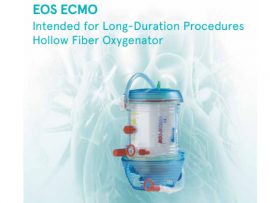Abstract The two hypnotic agents currently used for the maintenance of general anesthesia during cardio-pulmonary bypass (CPB) are propofol and sevoflurane. Propofol can be administered directly in the cardiotome of..
Lee masAbstract The International Liaison Committee on Resuscitation engages in a continuous review of new, peer-reviewed, published cardiopulmonary resuscitation and first aid science. Draft Consensus on Science With Treatment Recommendations are..
Lee masAbstract Rationale: Definitive guidelines for anticoagulation management during veno-venous extracorporeal membrane oxygenation (VV ECMO) are lacking, while bleeding complications continue to pose major challenges. Objectives: To describe anticoagulation modalities and..
Lee masAbstract Hemostatic disturbances after cardiac surgery can lead to excessive postoperative bleeding. Thromboelastography (TEG) was employed to evaluate perioperative coagulative alterations in patients undergoing cardiac surgery with cardiopulmonary bypass (CPB),..
Lee masAbstract A restrictive fluid strategy is recommended in patients with acute respiratory distress syndrome (ARDS) managed with venovenous extracorporeal membrane oxygenation (VV ECMO). However, there are no established predictors for..
Lee masAbstract OBJECTIVES: To determine the concordance between activated partial thromboplastin time (aPTT) and anti-factor-Xa (anti-Xa) in adults undergoing extracorporeal membrane oxygenation (ECMO) and to identify the factors associated with discordant..
Lee masAbstract Mortality prediction for patients with the severe acute respiratory distress syndrome (ARDS) supported with veno-venous extracorporeal membrane oxygenation (VV-ECMO) is challenging. Clinical variables at baseline and on day 3..
Lee masAbstract Mechanical circulatory support for cardiogenic shock complicated by acute severe aortic regurgitation poses a unique challenge for traditional veno arterial extracorporeal membrane oxygenation (ECMO) because of rapidly rising left..
Lee masAbstract The Extracorporeal Life Support Organization (ELSO) registry which collects data from hundreds of participating centers supports research in ECMO to help improve patient outcomes. The ELSO Scientific Oversight Committee,..
Lee masAbstract Background Our previous showed that a blood management program in the cardiopulmonary bypass (CPB) department, reduced red blood cell (RBC) transfusion and complications, but assessing transfusion practice solely based..
Lee masAn International Survey of Extracorporeal Membrane Oxygenation Education and Credentialing Practices
Abstract Background: The use of extracorporeal membrane oxygenation (ECMO) has grown rapidly over the past decades because of evolving indications, advances in circuit technology, and encouraging results from modern trials. Because..
Lee masAbstract Achievement of complete hemostasis is a key element to success in cardiac surgery. Bleeding control is of utmost importance in minimally invasive and robotic cardiac surgery to avoid conversion,..
Lee masAbstract Targeted oxygen delivery during cardiopulmonary bypass (CPB) has received significant attention due to its influence on patient outcomes, especially in mitigating acute kidney injury. While it has gained popularity..
Lee masAbstract BACKGROUND: Bleeding is a serious complication of cardiopulmonary bypass (CPB) in neonates. Blood product transfusions are often needed to adequately restore hemostasis, but are associated with significant risks. Thus,..
Lee masAbstract Purpose: Intensive care unit-acquired weakness (ICUAW) affects patient prognosis after cardiopulmonary bypass (CPB) surgery, but its risk factors remain unclear. We investigated these risk factors and developed a nomogram..
Lee masAbstract OBJECTIVES Previous studies indicated higher long-term mortality after the transfusion of allogeneic red blood cells (RBC); newer recommendations emphasize lower transfusion rates. The consequences of the transfusion of RBCs..
Lee masAbstract Background: Although extracorporeal membrane oxygenation (ECMO) is an integral part of a robust cardiogenic shock program, it is associated with high mortality. The optimal strategy for weaning from ECMO is..
Lee masAbstract Infection is one of the most frequent complications in the management of ECMO patients. Although there are several studies demonstrating the role of ECMO in patients with pre-existing sepsis,..
Lee masAbstract Beside the tremendous developments in cardiac surgical procedures, the use of cardiopulmonary bypass (CPB) remains the gold standard to perform cardiac surgery but is associated with detrimental effects (e.g...
Lee masAbstract Background: Extubation while receiving V-V ECMO is being considered earlier for patients with respiratory failure. This can facilitate early mobilization, participation in physical therapy, and reduce the potential consequences of..
Lee masAbstract Introduction: In cardiogenic shock, peripheral veno-arterial extracorporeal membrane oxygenation (VA-ECMO) can provide hemodynamic support, however this results in adverse left ventricular afterload. Left ventricle (LV) venting (unloading) has favorable effects..
Lee masAbstract BACKGROUND & OBJECTIVE: We aimed to evaluate the effect of sitaxentan on renal microvascular perfusion via application of ultrasound microbubble contrast. METHODS: Male beagles were randomly divided into: Sham,..
Lee masAbstract Objectives A conservative hemoglobin transfusion threshold is noninferior to a liberal threshold in cardiac surgery. However, red blood cell (RBC) transfusion remains common during cardiac surgery. The authors’ single-center,..
Lee masAbstract Purpose: Patients who are successfully resuscitated following out‑of‑hospital cardiac arrest (OHCA) are still at a highrisk of neurological damage and death. Inflammation and brain injury are components of the..
Lee masAbstract Introduction Most patients on extracorporeal membrane oxygenation (ECMO) decease during therapy on the system. However, the actual causes of death have not been studied sufficiently. This study analyses the..
Lee masAbstract Background Gender disparity in the cardiothoracic surgery workforce is challenging to enumerate and quantify. The purpose of our work is to use the most current data to quantify the..
Lee masAbstract The cardiac operating room (OR) is a high-risk, high-stakes environment inserted into a complex socio-technical healthcare system. During cardiopulmonary bypass (CPB), the most critical phase of cardiac surgery, the..
Lee masAbstract Neurological pupil index (NPi) calculated by automated pupillometry predicts clinical outcomes in critically ill patients. However, there are few data on intraoperative NPi and postoperative outcome after cardiac surgery...
Lee masAbstract Objectives del Nido cardioplegia is utilized for myocardial protection in adult patients undergoing cardiac surgery; however, no standardized re-dosing protocol exists. We describe perfusion characteristics and clinical outcomes in..
Lee masAbstract Background Patients with simultaneous relevant internal carotid artery stenosis and coronary artery heart or valve disease represent a high-risk collective with respect to cerebral or cardiovascular severe events when..
Lee mas
















